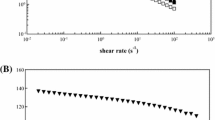Abstract
The ability of polysaccharides to enhance viscosity and to form gels has led to their widespread use in food products. Often synergistic combinations of polysaccharides are employed in order to manipulate rheological characteristics and, in addition, to provide effective savings in production costs. Common examples of polysaccharide blends used include kappa-carrageenan-galactomannan, xanthan-galactomannan and alginate-pectin. The origin of the synergy in these polysaccharide mixtures has been the subject of extensive research studies over the last twenty years or so and still gives rise to considerable controversy 1,2. Cairns et al 3 have identified four different types of gel structure that might arise in binary mixtures of polysaccharides and these are illustrated in figure 1. In structure a) only one of the polysaccharides contributes to the gel network and the second polymer is simply entrapped within the matrix. In structure b) both polysaccharides form independent penetrating networks. Structure c) arises if polymer demixing occurs prior to gelation giving a phase separated network and structure d) is termed a coupled network and arises when sections of the two polysaccharides associate.
Access this chapter
Tax calculation will be finalised at checkout
Purchases are for personal use only
Preview
Unable to display preview. Download preview PDF.
Similar content being viewed by others
References
P.A. Williams and G.O. Phillips “Interactions in mixed polysaccharide system”sin “Food Polysaccharide”sA.M.Stephen and I.C.M.Dea eds Marcel Dekker (in press).
E.R.Morris “Mixed Polymer Gel”sin “Food Gel”sP.Harris ed Elsevier Applied Science Series (1990) (p291).
P. Cairns, M.J.Miles, VJ.Morris and G.J.Brownsey “X-ray fibre diffraction studies on synergistic, binary polysaccharide gel”sCarbohydr. Res. 160:411 (1987).
E.R. Morris, D.A.Rees, G.Young, M.D.Walkinshaw and A.Darke “Order-disorder transition for a bacterial polysaccharide in solution” J. Mol. Biol. 110:1 (1977).
M. Milas and M.Rinaudo “Properties of xanthan gum in aqueous solutions: Role of the conformational transition” Carbohydr. Res. 158:191 (1986).
I.T. Norton, D.M.Goodall, S.A.Frangou, E.R.Morris and D.A.Rees “Mechanism and dynamics of conformational ordering in xanthan polysaccharide” J. Mol. Biol. 175:371 (1984).
V. Crescenzi, M.Dentini and L.Pietrelli “Protonation equilibriums of the polysaccharide xanthan in aqueous solution” Period. Biol. 83:125 (1981).
A. Gamini, J. de Bleijser and J.C.Leyte “Physico-chemical properties of aqueous solutions of xanthan: An nmr study”Carbohydr. Res. 220:33 (1991).
J.K.Rocks “Xanthan gu”mFood Technology 25:22 (1971).
D.A.Rees “Shapely Polysaccharide”sBiochem. J. 126:257 (1972).
I.C.M. Dea, E.R.Morris, D.A.Rees, E.J.Welsh, H.A.Barnes and J. Price “Associations of like and unlike polysaccharides: mechanism and specificity in galactomannans, interacting bacterial polysaccharides and related systems”Carbohydr. Res. 57:249 (1977).
E.R. Morris, D.A.Rees, G.Robinson and G.Young “Competitive inhibition of interchain interactions in polysaccharide system”sJ. Mol. Biol. 138:363 (1980).
B.V.McCleary “Enzyme hydrolysis, fine structure and gelling interaction of legume- seed D-galacto-D-mannan” Carbohydr. Res. 71:205 (1979).
M. Tako and S.Nakamura “D-Mannose specific interaction between xanthan and D- galacto-D-mannan” Feb. Letts. 204:33 (1986).
M.Tako and S. Nakamura “Synergistic interaction between xanthan and guar gu”mCarbohydr. Res. 138:207 (1985).
M.Tako “Synergistic interaction between deacetylated xanthan and galactomannan” J. Carbohydrate Chem. 10:619 (1991).
P. Cairns, M.J.Miles and V.J.Morris “Intermolecular binding of xanthan gum and carob gu”mNature 322:89 (1986).
V.J.Morris “Designing polysaccharides for synergistic interaction” in “Gums and Stabilisers for the Food Industry ”6G.O.Phillips, P.A.Williams and D.J.Wedlock eds Oxford University Press Publishers (1992) p161.
G.J. Brownsey, P.Cairns, M.J.Miles and V.J.Morris “Evidence for intermolecular binding between xanthan and the glucomannan konjac mannan” Carbohydr. Res. 176:329 (1988).
N.W.H. Cheetham, B.V.McCleary, G.Teng, F.Lum and Maryanto “Gel permeation studies on xanthan-galactomannan interaction”sCarbohydr. Polymers 6:257 (1986).
N.W.H.Cheetham “Xanthan-galactomannan interactions-A gpc stud”yin “Industrial Polysaccharide”sS.S.Stivala, V.Crescenzi and I.C.M.Dea eds Gordon and Breach Publishers (1987) p325.
N.W.H. Cheetham and A.Punruckvong “Gel permeation and optical rotation studies on xanthan-galactomannan interaction”sCarbohydr. Polymers 10:129 (1989).
N.W.H. Cheetham and E.N.M.Mashimba “Conformational aspects of xanthan- galactomannan gelation. Further evidence from optical rotation studies. ”Carbohydr. Polymers 14:17(1991).
N.W.H. Cheetham and E.N.M.Mashimba “Conformational aspects of xanthan- galactomannan gelation” Carbohydr. Polymers 9:195 (1988).
L. Lopes, C.T.Andrade, M.Milas and M.Rinaudo “Role of conformaton and acetylation of xanthan on xanthan-guar interaction”sCarbohydr. Polymers 17:121 (1992).
P.A. Williams, S.M.Clegg, D.H.Day, G.O.Phillips and K.Nishinari “Mixed gels formed with konjac mannan and xanthan gu”min “Food Polymers, Gels and Colloid”sE.Dickinson ed Royal Society of Chemistry Special Publ. 82 (1991) p339.
P.A. Williams, D.H.Day, MJ.Langdon, G.O.Phillips and K.Nishinari “Synergistic interaction of xanthan gum with glucomannans and galactomannan”sFood Hydrocolloids 4:489(1991).
Author information
Authors and Affiliations
Editor information
Editors and Affiliations
Rights and permissions
Copyright information
© 1994 Springer Science+Business Media New York
About this chapter
Cite this chapter
Williams, P.A., Annable, P., Phillips, G.O., Nishinari, K. (1994). Mixed Polysaccharide Gels Formed between Xanthan Gum and Glucomannan. In: Nishinari, K., Doi, E. (eds) Food Hydrocolloids. Springer, Boston, MA. https://doi.org/10.1007/978-1-4615-2486-1_67
Download citation
DOI: https://doi.org/10.1007/978-1-4615-2486-1_67
Publisher Name: Springer, Boston, MA
Print ISBN: 978-1-4613-6059-9
Online ISBN: 978-1-4615-2486-1
eBook Packages: Springer Book Archive




